

Catalpa is a true garden-enhancing tree. It offers unique shade foliage & flowers.
A summary of key Catalpa facts
Name – Catalpa
Family – Bignoniaceae
Type – Tree
Height – 26 to 32 feet (8 to 10 meters)
Exposure – Full sun
Soil type: ordinary – Leafage: deciduous – Blooming: mid-summer
This fast-growing tree is also very hardy in winter.
Catalpa is an easy tree to grow. It will settle in properly in any type of soil, even though, as for most trees, it prefers well-draining soil.
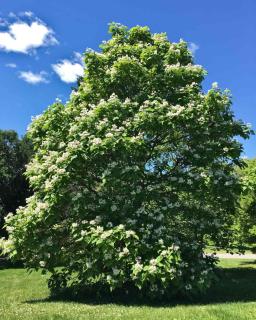 The Orchid flower tree is extremely ornamental: in spring and summer, bright green leaves and nice flowers strike home. In fall, leaves turn a beautiful yellow hue. Try to find a spot for it apart from other trees so you can highlight its beauty.
The Orchid flower tree is extremely ornamental: in spring and summer, bright green leaves and nice flowers strike home. In fall, leaves turn a beautiful yellow hue. Try to find a spot for it apart from other trees so you can highlight its beauty.
This tree loves sunlight, which makes it an excellent shade tree.
Catalpa is a fast grower, which makes it ideal if you’re planning a shaded spot in the garden to savor in only a few year’s time.
Though Catalpa will do perfectly fine without any pruning at all, it’s possible to prune it now and then for maintenance.
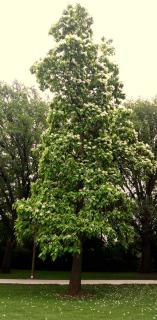 Best prune after leaves have fallen, or at the end of winter (when it doesn’t freeze hard any more).
Best prune after leaves have fallen, or at the end of winter (when it doesn’t freeze hard any more).Indeed, Catalpa starts growing with a thin, upright figure that tends to round off with age.
If it’s properly settled in, you can go for years without caring for the tree at all.
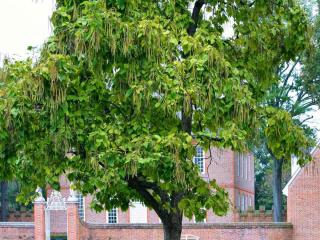 Perhaps only a little watering in summer during the first and second year will help it spread its roots, depending on the climate and weather.
Perhaps only a little watering in summer during the first and second year will help it spread its roots, depending on the climate and weather.
In dryer areas, mulch the tree around the trunk and all the way to where midday sun lays shade.
Though there are several species within the Catalpa genus, the one you’re likely to come across it Catalpa bignonioides.
Native to North America and Asia, Catalpa is a wonderful tree thanks to its blooming shown in the picture above/right. It also works wonders as a cool shade tree.
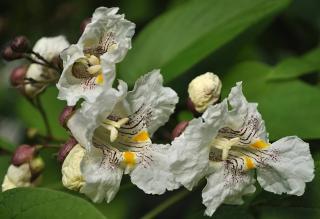
Spectacular and abundant flowers appear in June, signaling the time to start taking advantage of the shelter Catalpa provides from scorching heat.
These bean-like pods are what gave the tree its name: in the Cherokee language, the word ‘Catalpa’ is a type of bean plant.
Growth is rapid, and will speed up even more if planted in a warm spot.
Three main diseases may affect a weakened Catalpa tree. These are all fungal diseases.
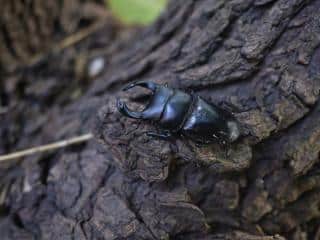 Verticilium wilt – Often fatal. Purple-gray streaks appear on wood when a branch is snipped. Leaves wilt, usually along an entire branch or along the sap-flow to one side of the tree.
Verticilium wilt – Often fatal. Purple-gray streaks appear on wood when a branch is snipped. Leaves wilt, usually along an entire branch or along the sap-flow to one side of the tree.
Leaf spot – Many possible culprits here. Usually the main fungus is Anthracnose, caused by Gloeosporium catalpae, but others also may appear.
During the first few years, spread mulch at the base of the tree to stimulate its growth.